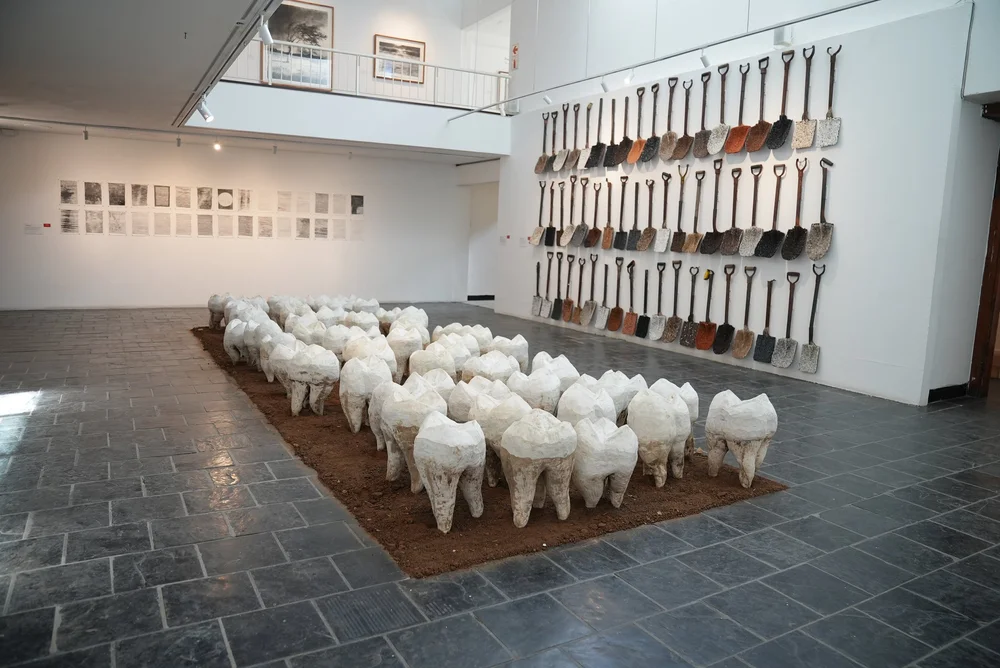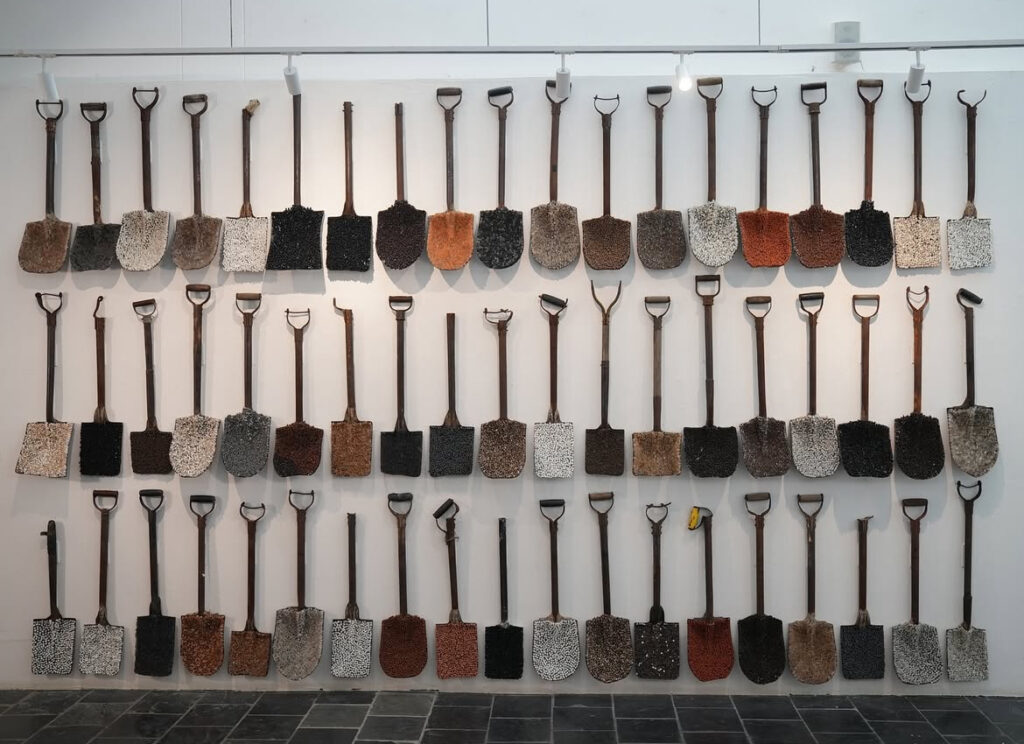AVA Gallery
07.08 - 25.09.2025
The first thing that hits you, walking into ‘Drawing the Line’, is the sheer magnitude of the work. Teeth. So many teeth. Rows and clusters of resin or clay molars spread across the room and on the walls like a strange dental parade. To the right, tooth-encrusted spades hang in neat ranks. Frantic line drawings flank the oversized tooth centrepiece. It reminds me of one of those anxiety dreams where all your teeth fall out – if you weren’t self-conscious about your dental health before, you certainly will be now. It’s orderly and unnerving at once.
Objects are not neutral. They’re haunted by the hands that held them; they store embedded memories. In ‘Drawing the Line’, Dr Adelheid Frackiewicz’s teeth and spades feel like a living archive: bones of other people’s labour, memories, and histories, surfacing in uncanny, bodily form.
Frackiewicz describes the teeth “as really being suggestive of a person, like human remains, or bones that are buried in the land.” The exhibition statement frames lines and teeth as a tribute to ancestors, the invisible multitude whose choices led to our improbable existence today. There’s a quiet awe in that idea: ancestry as arithmetic, roots traced through bone.
The exhibition might honour ancestry, but its materials also nod to fragility —how people vanish. Teeth here are intimate yet communal, sculptural and monumental, perhaps slightly grotesque. The tooth is the only bone in our body that is constantly exposed, in which the internal becomes public.
What’s fascinating is the scale: in Down the Line, thousands of resin-cast teeth, earth-coloured and tightly gridded, form a wall. It’s almost difficult not to think of other, darker histories and interpretations. A friend told me the works made her think of the Zama Zamas, referencing the trapped illegal miners who starved underground last year. Once she said it, I couldn’t unsee it: the claustrophobia, the rows, the echo of lives lived (and lost) out of sight. Not the artist’s intention, but art leaks; it mutates in your head.
In The Bottom Line, spades encrusted with the same resin-cast teeth are arranged in two rows, blades down, like they’ve dug too many holes and are now resting. Beyond a meditation on death and ancestry, The Bottom Line becomes a meditation on labour as life’s bottom line. Dr Frackiewicz elaborates: “When we work with found objects, they have a history that we are not privy to, but some objects really show this history, [like the spades signifying] hard labour…in their visual quality you can see how they’ve been worn or used.” Tools always have ghosts baked into them — labour, sweat, earth, death. The spade is banal, but in this context, it hums with existential resonance.
“Spades…touch on memory…the found object is embodied with its own history…” says Frackiewicz, adding that she has also tried to frame “[the spade as] a found line.” Each blade, with its scars and rust, becomes a kind of drawing in three dimensions. You can feel the labour embedded in the object. The human effort.
The drawings, though, tell a quieter, but equally obsessive story. They feel like diary entries next to the sculptural elements — the artist’s hand visible in the act of counting, erasing, reassembling. There’s a tension here: the intimate, fragile marks of the drawings converse uneasily with the monumental, almost brutal presence of the sculptural teeth and spades. In Out of Line, even the glued eraser rubbings begin to take on a sculptural weight.
“[The eraser rubbings] naturally developed,” Frackiewicz explains. “I draw the line, scratch or etch the line into the paper and then rub the pencil off the top surface of the paper…[I connect this] to violent histories…where one group tries to eradicate another group…the idea of trying to rub off…the more you’re rubbing off, the more material you are creating…it’s a kind of protest, you can try and erase this drawing, but the more you try to erase the process, the more visible the drawing becomes.”
Hearing her voice changed how I saw the work. Those erasures became less about absence and more about survival: scraping back, keeping the residue, building a new surface from what was rubbed away. Instead of destroying, the act of rubbing away builds. It leaves traces; marks of resilience. Frackiewicz links this process to her Polish ancestry — her grandfather’s migration to South Africa and the inherited silence around violence and loss. The paper, pencil, and eraser become actors in this story. They hold what’s too large or too fractured to say directly.
“I started thinking about my own practice in terms of the personal ritual way, doing things over and over was constructive and temporarily soothing,” explains Dr Frackiewicz. The repetition — whether rows of spades, lines of teeth, or pencil marks across paper — feels like the residue of a time-based performance. Like someone kept doing something every day until it became a wall that couldn’t be ignored. It’s both soothing and unnerving.
That ambivalence, that balance between reverence and repulsion, is what keeps you drawn to the exhibition. But ‘Drawing the Line’ isn’t about comfort. It’s about noticing the textures of existence—whether it’s the smooth line of a pencil, the cold hardness of cast resin, or the uncanny intimacy of a tooth in your hand. It leaves you counting teeth, touching your own gums, thinking about graves and erasures and what sticks to the page after you’ve tried to rub it out. It lets the material do the talking, and it trusts you enough not to fill in the blanks. That’s the line it’s drawn: between you and your own invisible histories, between labour and loss, between the body and the ground and whatever has come before.
This review was produced as a part of the AVA Art Writing Workshop, facilitated by Keely Shinners. This project was made possible thanks to the support by the City of Cape Town.










